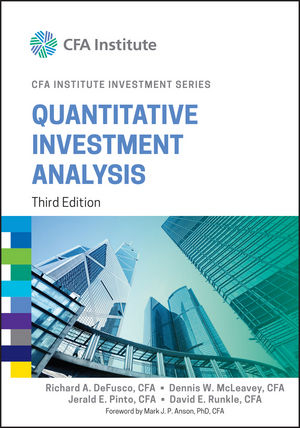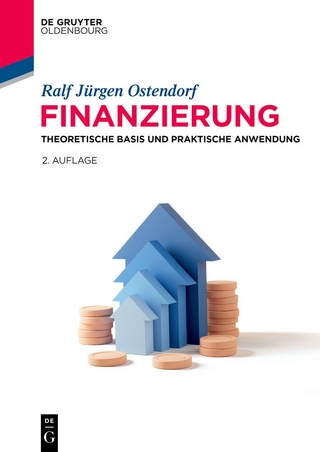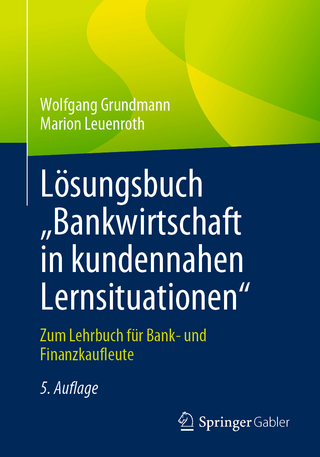
Quantitative Investment Analysis
John Wiley & Sons Inc (Verlag)
978-1-119-10422-3 (ISBN)
- Titel erscheint in neuer Auflage
- Artikel merken
Your complete guide to quantitative analysis in the investment industry Quantitative Investment Analysis, Third Edition is a newly revised and updated text that presents you with a blend of theory and practice materials to guide you through the use of statistics within the context of finance and investment. With equal focus on theoretical concepts and their practical applications, this approachable resource offers features, such as learning outcome statements, that are targeted at helping you understand, retain, and apply the information you have learned. Throughout the text's chapters, you explore a wide range of topics, such as the time value of money, discounted cash flow applications, common probability distributions, sampling and estimation, hypothesis testing, and correlation and regression. Applying quantitative analysis to the investment process is an important task for investment pros and students. A reference that provides even subject matter treatment, consistent mathematical notation, and continuity in topic coverage will make the learning process easier and will bolster your success.
* Explore the materials you need to apply quantitative analysis to finance and investment data even if you have no previous knowledge of this subject area * Access updated content that offers insight into the latest topics relevant to the field * Consider a wide range of subject areas within the text, including chapters on multiple regression, issues in regression analysis, time-series analysis, and portfolio concepts * Leverage supplemental materials, including the companion Workbook and Instructor's Manual, sold separately Quantitative Investment Analysis, Third Edition is a fundamental resource that covers the wide range of quantitative methods you need to know in order to apply quantitative analysis to the investment process.
RICHARD A. DFUSCO, CFA, is a Professor of Finance at the University of Nebraska-Lincoln. He earned his CFA charter in 1999 and started CFA grading in 2000. DENNIS W. MLEAVEY, CFA, is Faculty Advisor to the Ram Fund and Professor Emeritus of Finance and OR/MS at the University of Rhode Island. He obtained his CFA charter in 1990 and began CFA grading in 1995. JERALD E. PINTO, PD, CFA, has been at CFA Institute since 2002 as Visiting Scholar, Vice President, and now Director, Curriculum Projects in the Credentialing Division for the CFA and CIPM Programs. DAVID E. RUNKLE, CFA, is Director of Quantitative Research for Trilogy Global Advisors, LP. He joined Trilogy in 2007 from Piper Jaffray, where he was an Investment Research Manager.
Foreword xiii Preface xv Acknowledgments xvii About the CFA Institute Investment Series xix Chapter 1 The Time Value of Money 1 Learning Outcomes 1 1. Introduction 1 2. Interest Rates: Interpretation 2 3. The Future Value of a Single Cash Flow 4 3.1. The Frequency of Compounding 9 3.2. Continuous Compounding 11 3.3. Stated and Effective Rates 12 4. The Future Value of a Series of Cash Flows 13 4.1. Equal Cash Flows Ordinary Annuity 14 4.2. Unequal Cash Flows 15 5. The Present Value of a Single Cash Flow 16 5.1. Finding the Present Value of a Single Cash Flow 16 5.2. The Frequency of Compounding 18 6. The Present Value of a Series of Cash Flows 19 6.1. The Present Value of a Series of Equal Cash Flows 19 6.2. The Present Value of an Infinite Series of Equal Cash Flows Perpetuity 24 6.3. Present Values Indexed at Times Other than t = 0 25 6.4. The Present Value of a Series of Unequal Cash Flows 26 7. Solving for Rates, Number of Periods, or Size of Annuity Payments 27 7.1. Solving for Interest Rates and Growth Rates 27 7.2. Solving for the Number of Periods 30 7.3. Solving for the Size of Annuity Payments 31 7.4. Review of Present and Future Value Equivalence 35 7.5. The Cash Flow Additivity Principle 37 8. Summary 38 Problems 38 Chapter 2 Discounted Cash Flow Applications 43 Learning Outcomes 43 1. Introduction 43 2. Net Present Value and Internal Rate of Return 44 2.1. Net Present Value and the Net Present Value Rule 44 2.2. The Internal Rate of Return and the Internal Rate of Return Rule 46 2.3. Problems with the IRR Rule 49 3. Portfolio Return Measurement 51 3.1. Money-Weighted Rate of Return 52 3.2. Time-Weighted Rate of Return 53 4. Money Market Yields 59 5. Summary 64 References 65 Problems 65 Chapter 3 Statistical Concepts and Market Returns 69 Learning Outcomes 69 1. Introduction 70 2. Some Fundamental Concepts 70 2.1. The Nature of Statistics 70 2.2. Populations and Samples 71 2.3. Measurement Scales 72 3. Summarizing Data Using Frequency Distributions 73 4. The Graphic Presentation of Data 81 4.1. The Histogram 82 4.2. The Frequency Polygon and the Cumulative Frequency Distribution 83 5. Measures of Central Tendency 86 5.1. The Arithmetic Mean 86 5.2. The Median 90 5.3. The Mode 93 5.4. Other Concepts of Mean 94 6. Other Measures of Location: Quantiles 103 6.1. Quartiles, Quintiles, Deciles, and Percentiles 103 6.2. Quantiles in Investment Practice 108 7. Measures of Dispersion 110 7.1. The Range 111 7.2. The Mean Absolute Deviation 111 7.3. Population Variance and Population Standard Deviation 113 7.4. Sample Variance and Sample Standard Deviation 116 7.5. Semivariance, Semideviation, and Related Concepts 120 7.6. Chebyshev s Inequality 121 7.7. Coefficient of Variation 123 7.8. The Sharpe Ratio 125 8. Symmetry and Skewness in Return Distributions 129 9. Kurtosis in Return Distributions 134 10. Using Geometric and Arithmetic Means 138 11. Summary 140 References 141 Problems 142 Chapter 4 Probability Concepts 151 Learning Outcomes 151 1. Introduction 152 2. Probability, Expected Value, and Variance 152 3. Portfolio Expected Return and Variance of Return 175 4. Topics in Probability 184 4.1. Bayes Formula 184 4.2. Principles of Counting 188 5. Summary 192 References 194 Problems 194 Chapter 5 Common Probability Distributions 199 Learning Outcomes 199 1. Introduction to Common Probability Distributions 200 2. Discrete Random Variables 200 2.1. The Discrete Uniform Distribution 202 2.2. The Binomial Distribution 204 3. Continuous Random Variables 214 3.1. Continuous Uniform Distribution 214 3.2. The Normal Distribution 218 3.3. Applications of the Normal Distribution 224 3.4. The Lognormal Distribution 226 4. Monte Carlo Simulation 232 5. Summary 239 References 240 Problems 241 Chapter 6 Sampling and Estimation 247 Learning Outcomes 247 1. Introduction 248 2. Sampling 248 2.1. Simple Random Sampling 248 2.2. Stratified Random Sampling 250 2.3. Time-Series and Cross-Sectional Data 251 3. Distribution of the Sample Mean 254 3.1. The Central Limit Theorem 254 4. Point and Interval Estimates of the Population Mean 258 4.1. Point Estimators 258 4.2. Confidence Intervals for the Population Mean 260 4.3. Selection of Sample Size 266 5. More on Sampling 268 5.1. Data-Mining Bias 268 5.2. Sample Selection Bias 271 5.3. Look-Ahead Bias 272 5.4. Time-Period Bias 272 6. Summary 274 References 276 Problems 276 Chapter 7 Hypothesis Testing 281 Learning Outcomes 281 1. Introduction 282 2. Hypothesis Testing 282 3. Hypothesis Tests Concerning the Mean 292 3.1. Tests Concerning a Single Mean 292 3.2. Tests Concerning Differences between Means 300 3.3. Tests Concerning Mean Differences 304 4. Hypothesis Tests Concerning Variance 308 4.1. Tests Concerning a Single Variance 308 4.2. Tests Concerning the Equality (Inequality) of Two Variances 310 5. Other Issues: Nonparametric Inference 314 5.1. Tests Concerning Correlation: The Spearman Rank Correlation Coefficient 315 5.2. Nonparametric Inference: Summary 317 6. Summary 318 References 320 Problems 320 Chapter 8 Correlation and Regression 327 Learning Outcomes 327 1. Introduction 328 2. Correlation Analysis 328 2.1. Scatter Plots 328 2.2. Correlation Analysis 329 2.3. Calculating and Interpreting the Correlation Coefficient 332 2.4. Limitations of Correlation Analysis 334 2.5. Uses of Correlation Analysis 337 2.6. Testing the Significance of the Correlation Coefficient 345 3. Linear Regression 348 3.1. Linear Regression with One Independent Variable 348 3.2. Assumptions of the Linear Regression Model 352 3.3. The Standard Error of Estimate 354 3.4. The Coefficient of Determination 357 3.5. Hypothesis Testing 359 3.6. Analysis of Variance in a Regression with One Independent Variable 367 3.7. Prediction Intervals 370 3.8. Limitations of Regression Analysis 373 4. Summary 373 Problems 375 Chapter 9 Multiple Regression and Issues in Regression Analysis 385 Learning Outcomes 385 1. Introduction 386 2. Multiple Linear Regression 386 2.1. Assumptions of the Multiple Linear Regression Model 392 2.2. Predicting the Dependent Variable in a Multiple Regression Model 398 2.3. Testing whether All Population Regression Coefficients Equal Zero 399 2.4. Adjusted R2 402 3. Using Dummy Variables in Regressions 403 4. Violations of Regression Assumptions 408 4.1. Heteroskedasticity 408 4.2. Serial Correlation 415 4.3. Multicollinearity 419 4.4. Heteroskedasticity, Serial Correlation, Multicollinearity: Summarizing the Issues 422 5. Model Specification and Errors in Specification 422 5.1. Principles of Model Specification 422 5.2. Misspecified Functional Form 423 5.3. Time-Series Misspecification (Independent Variables Correlated with Errors) 431 5.4. Other Types of Time-Series Misspecification 435 6. Models with Qualitative Dependent Variables 435 7. Summary 438 References 440 Problems 441 Chapter 10 Time-Series Analysis 459 Learning Outcomes 459 1. Introduction to Time-Series Analysis 460 2. Challenges of Working with Time Series 462 3. Trend Models 462 3.1. Linear Trend Models 463 3.2. Log-Linear Trend Models 466 3.3. Trend Models and Testing for Correlated Errors 471 4. Autoregressive (AR) Time-Series Models 472 4.1. Covariance-Stationary Series 472 4.2. Detecting Serially Correlated Errors in an Autoregressive Model 474 4.3. Mean Reversion 477 4.4. Multiperiod Forecasts and the Chain Rule of Forecasting 477 4.5. Comparing Forecast Model Performance 481 4.6. Instability of Regression Coefficients 482 5. Random Walks and Unit Roots 485 5.1. Random Walks 485 5.2. The Unit Root Test of Nonstationarity 489 6. Moving-Average Time-Series Models 494 6.1. Smoothing Past Values with an n-Period Moving Average 494 6.2. Moving-Average Time-Series Models for Forecasting 496 7. Seasonality in Time-Series Models 499 8. Autoregressive Moving-Average Models 504 9. Autoregressive Conditional Heteroskedasticity Models 504 10. Regressions with More than One Time Series 507 11. Other Issues in Time Series 512 12. Suggested Steps in Time-Series Forecasting 512 13. Summary 514 Problems 516 Chapter 11 Introduction to Multifactor Models 525 Learning Outcomes 525 1. Introduction 525 2. Multifactor Models and Modern Portfolio Theory 526 3. Arbitrage Pricing Theory 527 4. Multifactor Models: Types 533 4.1. Factors and Types of Multifactor Models 533 4.2. The Structure of Macroeconomic Factor Models 534 4.3. The Structure of Fundamental Factor Models 537 5. Multifactor Models: Selected Applications 541 5.1. Factor Models in Return Attribution 542 5.2. Factor Models in Risk Attribution 545 5.3. Factor Models in Portfolio Construction 549 5.4. How Factor Considerations Can Be Useful in Strategic Portfolio Decisions 551 6. Summary 552 References 554 Problems 554 Appendices 557 Glossary 567 About the Editors and Authors 579 About the CFA Program 581 Index 583
| Erscheint lt. Verlag | 26.2.2016 |
|---|---|
| Reihe/Serie | The CFA Institute Series |
| Verlagsort | New York |
| Sprache | englisch |
| Maße | 186 x 258 mm |
| Gewicht | 1284 g |
| Themenwelt | Wirtschaft ► Betriebswirtschaft / Management ► Finanzierung |
| ISBN-10 | 1-119-10422-X / 111910422X |
| ISBN-13 | 978-1-119-10422-3 / 9781119104223 |
| Zustand | Neuware |
| Haben Sie eine Frage zum Produkt? |
aus dem Bereich



